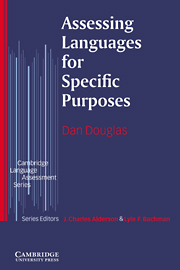Book contents
- Frontmatter
- Contents
- Series editors' preface
- Acknowledgements
- 1 Why test language for specific purposes?
- 2 Specific purpose language ability
- 3 Context, discourse domains, and task characteristics
- 4 Strategic competence: between knowledge and context
- 5 From target language use to test tasks
- 6 Specific purpose tests of listening and speaking
- 7 Specific purpose tests of reading and writing
- 8 LSP test development and technology
- Appendix: other LSP tests
- References
- Index
5 - From target language use to test tasks
Published online by Cambridge University Press: 03 May 2010
- Frontmatter
- Contents
- Series editors' preface
- Acknowledgements
- 1 Why test language for specific purposes?
- 2 Specific purpose language ability
- 3 Context, discourse domains, and task characteristics
- 4 Strategic competence: between knowledge and context
- 5 From target language use to test tasks
- 6 Specific purpose tests of listening and speaking
- 7 Specific purpose tests of reading and writing
- 8 LSP test development and technology
- Appendix: other LSP tests
- References
- Index
Summary
Introduction
In Chapter 2, 1 discussed a theory of language ability, and in particular the theoretical construct of specific purpose language ability that we attempt to measure with LSP tests. In Chapter 3, the topic was the nature of context and the theory of how context can be described in terms of task characteristics which can then be translated into test tasks. In this chapter, I will develop guidelines and techniques for constructing LSP tests, focussing particularly on techniques for investigating and describing the target language use situations that form the basis for identifying specific purpose test tasks. The same techniques will also provide a basis for evaluating LSP tests, in terms of test method characteristics, and for interpreting test performance, based on the understanding that test performances are the result of an interaction between test taker attributes (e.g., language ability and specific purpose background knowledge) and the context, as established by the characteristics of the test methods. I will begin the discussion of techniques for LSP test development by considering techniques for investigating target language use situations: grounded ethnography, contextbased research, and subject specialist informant procedures. I will then outline a framework for analyzing specific purpose TLU situations, based on the discussion in Chapter 3, considering a concrete example along the way. I will end with a discussion and example of LSP test specifications, finally illustrating how to apply the analytical framework to the description of test task characteristics.
Techniques for investigating the target language use domain
We saw in Chapter 2 that input data vary greatly in their level of specificity and that this variation is not necessarily obvious to test developers.
Information
- Type
- Chapter
- Information
- Assessing Languages for Specific Purposes , pp. 92 - 128Publisher: Cambridge University PressPrint publication year: 1999
